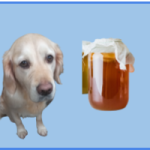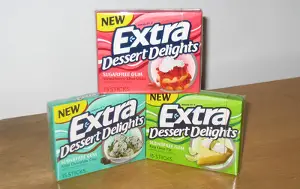Despite your best intentions, has your dog stolen a croissant from your kitchen counter when you weren’t looking or whilst you were out?
Or perhaps there is nothing you like more on a Saturday morning than to eat a croissant for breakfast?
And unable to resist the charm offensive from Fido as he looks at you with those adorable eyes…
You are wondering if it would be so bad to share your croissant?
And that is exactly what this article is about.
Can my dog eat croissants and how much harm could they do?
It won’t come as any surprise to you that croissants won’t be found on any list of “top healthy foods to feed your dog” or that they won’t count as one of your dog’s fine a day.
The main ingredients of a croissant are flour, butter, water, sugar and yeast.
These are standard ingredients found in most breads.
None of these ingredients are particularly good for your dog but neither are they toxic if a dog accidentally eats one or two croissants.
The biggest ingredients in croissants are flour and butter.
So let’s discuss these first.
Is flour toxic to my dog?
Most of the flour that we consume is wheat flour, which isn’t toxic for your dog unless they have a wheat allergy.
It is unlikely that the flour in the croissant will cause your dog any distress.
It might, at its worst, cause them to have a mildly upset stomach but even that is unlikely.
Is butter harmful for my dog?
Butter is slightly different because of its fat content.
This is far more likely to upset your dog’s stomach but it shouldn’t cause much more distress.
I mean, if your dog ate a block of butter, then you might be concerned about pancreatitis.
But the amount of butter in the odd bite or two of a croissant should not cause your dog any health risk.
Another “croissant” ingredient that I want to discuss with you is almond and this can be found in the more luxurious end of the croissant market.
Will almonds kill my dog?
Almonds don’t poison your dog but they aren’t ideal to feed to your dog either.
The biggest threat that these almonds pose to your dog is that they tend to be flaked and therefore they might cause a choking hazard.
This depends on how big your dog is (and how big their throat is) and how few bites the dog “wolfs” the croissant down in.
If your dog doesn’t chew his food then he might struggle to swallow large chunks of bread.
Two croissant ingredients that could kill your dog
If you are partial to a croissant now and again for breakfast and you like to share it with your dog then there are two potentially lethal ingredients that might be in your croissant or in many other baked goods.
The two ingredients are raisins and xylitol.
Could raisins kill my dog?
I have written this article about grape jelly in which I discuss how dangerous grapes are to dogs.
And raisins are exactly the same.
Scientists don’t know why raisins are so toxic to dogs but they do know that it only takes a few raisins to potentially kill a small dog.
Symptoms to look out for include lethargy, abdominal pain and tremors.
Is xylitol toxic to my dog?
Xylitol is an artificial sweetener which is used in “sugar free” products.
It is found most commonly in products like peanut butter and it is added to some baked goods.
Although I can’t find any commercially available croissants that have it listed as an ingredient but there are some croissant recipes online that use it.
Xylitol when ingested by a dog can cause a large increase in the amount of insulin that is produced which might result in your dog’s blood sugar levels falling to dangerously low levels.
Symptoms to look out for include: vomiting, weakness, seizures or comas.
How do I stop my dog from eating croissants?
There are two situations to contend with here.
My dog has stolen a croissant
Firstly, is the situation where your dog has eaten a croissant or croissants because they have stolen it.
Maybe one of your kids left a partially eaten croissant on the table this morning or maybe you might have left some on the kitchen counter as you rushed out of the door to take the kids to school.
It is hard to plan for such events as this.
As organised as you might be, there will always be occasions in which things go wrong because something unexpected happened.
Telling you to make sure that you never leave a stray croissant around simply won’t work when you are trying your best to be as organised as possible.
My dog shares my croissant
The second issue is when your dog is eating croissants because you are feeding them to them.
Lots of people admit to sharing their food with their dog and feeding them from the table.
This isn’t surprising as dogs become more important in our lives.
In this survey from 2014, 34% of people fed their dogs scraps from the table.
And habits such as these are very hard to change.
Clearly, croissants aren’t good for your dog and if you do want to share some of your food with your dog, you might be better feeding them scraps of vegetables.
Or if it has to be bread, just limit the amounts and make sure that there is no butter, jelly or peanut butter on it.
Bread dough can kill your dog
Earlier in this article I mentioned homemade croissants in passing.
And I also mentioned that a key ingredient in croissants is yeast.
Now most of us simply can’t be bothered to make croissants from scratch or we haven’t the time.
But if you are a dog owner who wants to make your own croissants then there is something else that you need to be aware of.
Most breads that are made use yeast.
Yeast helps to shape the bread and make it rise from a flat shape.
The process is called proving and it involves leaving the bread in a warm place for a couple of hours and letting it “rise”.
Any uncooked bread that has yeast in it is potentially lethal to your dog.
Yeast causes a reaction in the bread which makes it expand and grow and if your dog eats it then this expansion will happen in your dog’s stomach.
With potentially lethal consequences.
Make sure that your croissant mix is in a secure place that your dog can’t access.






